25 Points: Sad Robot Stories
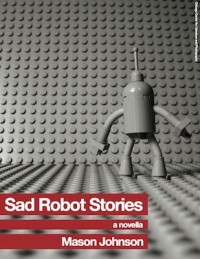 Sad Robot Stories
Sad Robot Stories
by Mason Johnson
CCLaP Publishing, 2013
126 pages / $22.00 ($4.99 Kindle Edition) buy from CCLaP or Amazon
1. What happens when the world goes deaf?
2. Sad Robot Stories by Mason Johnson is a novella about Robot and “his” existential crisis after the collapse of the world, left only with “his” mechanical “brothers” and “sisters” and the usual fire and brimstone of an apocalypse setting.
3. Maybe deaf is the wrong word. Or the wrong cadence. What happens when the sound of humans is extinguished? “Yes, the cries, giggles, laughter, screams, moans of both pain and pleasure, squeals, wails, whispers–the many sounds of the human race–were all gone. Even the minute sound of blood rushing through veins and arteries, speeding through the heart and up to the brain…was gone.” Could you, theoretically, if you didn’t die and weren’t some pile of dust eating radioactivity, I mean, could you handle it?
4. Robot is special or different than his siblings in that his emotional spectrum has for some reason also been anthropomorphized. He is, like the title suggests, sad that the humans are gone.
5. Humans have created (in our world) a null-sound room–which one research team has monikered as a Dead Room–that most scientists call an anechoic chamber, in order to develop and test various auditory waves.
6. “An anechoic chamber (an-echoic meaning non-echoing or echo-free) is a room designed to completely absorb reflections of either sound or electromagnetic waves. They are also insulated from exterior sources of noise. The combination of both aspects means they simulate a quiet open-space of infinite dimension, which is useful when exterior influences would otherwise give false results.” (Wikipedia)
7. Robot specifically misses from the human race Mike and Mike’s nuclear family. Mike was the first human to acknowledge (or perhaps ignore) Robot’s being. “Being” here couples physical and metaphysical, which, according to more Wikipedia, is exactly anathema to Speculative Realism. Speculative Realism, from the one article I read, argues for the multiple possibilities of reality; that no one universal law is stable according to these multiple possibilities (with the exception of the Principle of Non-Contradiction); “there is no reason [the universe] could not be otherwise.” A good ground rule for any Science Fiction.
8. In the anthropocentric world of Robot pre- human extinction, there are workplace laws managing the ratio of humans-to-robots, which presumptuously leads to pay differences, benefits, etc. Like any class distinction, humans have structured a wall to stand on in order to look down upon those below, i.e. robots. Mike plays pool with Robot, takes Robot home to meet his family. He tells Robot stories of his life. He treats “him” like a friend.
9. “Anechoic chambers, a term coined by American acoustics expert Leo Beranek, were originally used in the context of acoustics (sound waves) to minimize the reflections of a room.”
10. Robot is fascinated not just by Mike’s stories of an alcoholic, nihilistic past, but of Mike’s budding fascination and subsequent redemption after Mike started reading books. This notion of the redemptive functions of books/stories is not objective. “And it is true that the tool is the congealed outline of an operation. But it remains on the level of the hypothetical imperative. I may use the hammer to nail up a case or to hit my nieghbour over the head.” (Jean-Paul Sarte, “What Is Literature?”) You read/write a story, why? READ MORE >
November 26th, 2013 / 11:09 am
Three Scenarios in Which Hana Sasaki Grows a Tail: Stories
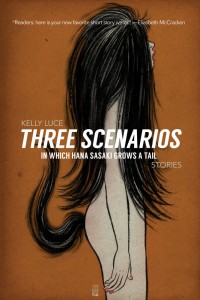 Three Scenarios in Which Hana Sasaki Grows a Tail: Stories
Three Scenarios in Which Hana Sasaki Grows a Tail: Stories
by Kelly Luce
A Strange Object, 2013
152 pages / $14.95 buy from A Strange Object
1. Three Scenarios in Which Hana Sasaki Grows a Tail is the debut story collection by Kelly Luce.
2. It fits on a bookshelf of modern Japanese writing somewhere between Yoko Ogawa’s Revenge and Banana Yoshimoto, maybe even one shelf up from Haruki Murakami.
3. The only thing is that Kelly Luce grew up in Brookfield, Illinois.
4. How strict is the “write what you know” edict? On Big Think, Nathan Englander reminds us that this advice is too often misconstrued. It really means we should write from a place of emotional familiarity, not that we’re limited to autobiographical writing.
5. But are there limitations when we talk about writers depicting foreign cultures? This story collection seems very Japanese (if a book can even be “very Japanese”) and yet, it’s distinctly American, too.
6. When I was nine I was flipping through channels and caught the end of Akira on basic cable. I had no clue what was going on, but in the weeks, months, and years to follow I found that it left an indelible mark on me—a predilection towards the uncomfortably strange.
7. A Strange Object is the name of the independent press that published Three Scenarios in Which Hana Sasaki Grows a Tail. They’re based out of Austin, TX. This is their first book, too.
8. This is strictly conjecture, but Japanese culture affords for a strangeness that is uniquely its own. Look at all of the Japanese fiction out there: Akutagawa and Mishima, Ryu Murakami and Haruki Murakami, and the scores of manga and J-horror.
9. The characters in Kelly Luce’s collection are outsiders. Many are Americans who move to Japan for work or to connect with the culture that they find so entrancing. Some are only half Asian, an anomaly to the native Japanese—not gaijin, but not Japanese, either. Others are fully Japanese, but do not fit in as with the Japanese school girls who seek refuge from the tedium of their lives through a unique karaoke machine and with the Japanese widower who invented a machine that measures a person’s capacity for love. All are lost. All are searching to fit in.
10. In ninth grade, I ordered a t-shirt with the kanji for gaijin on it. I wore that shirt proudly even though no one at my school in West Tennessee understood what it meant. Looking back, I think I was so drawn to Japanese comic books and cartoons because it was a way to embrace my otherness as a nerdy, awkward white boy. READ MORE >
November 14th, 2013 / 11:14 am
25 Points: A High Wind in Jamaica
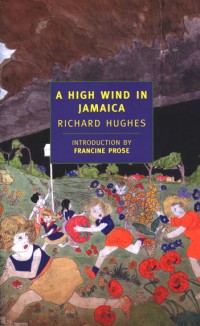 A High Wind in Jamaica
A High Wind in Jamaica
by Richard Hughes
NYRB Classics, 1999
279 pages / $14.00 buy from NYRB or Amazon
1. On the surface, Richard Hughes’s A High Wind in Jamaica is a dot-to-dot adventure tale. After a hurricane hits an English settlement in Jamaica, two families decide to send their children back to England. Early on in the voyage the children are taken aboard a pirate ship whereupon they visit exotic ports and busy themselves with imaginary games. They are eventually returned home, and the pirates’ subsequent arrest, trial, and execution rounds out the proceedings. Of course, that last part seems a little extreme and out of place, and that’s really the book’s program, because simmering just below this surface is the constant threat of rape and murder.
2. In the spirit of Calvino’s later lecture on lightness versus weight, the narrative manages to float just above the threat of violence. You get the feeling after a while that Hughes is totally aware that you’re aware of the divide between high adventure and childhood trauma, and so he starts to fuck with your sense that awful things need to happen.
3. And, of course, awful things do happen—often and with startling frankness—but they are always quickly buried under the book’s relentless trend towards lightness.
4. The earliest memory I have is of staring up at the bottom of a kitchen table. I don’t know where I was or what I was doing, but I remember looking at a pattern in the wood and then turning toward a doorway. That’s it. I know I’ve told the memory differently over the years, adding in details about toys or sounds or maybe a smell wafting in, but the truth is that I just have this one scant moving image. I don’t think it’s a lie to embellish something so bland and colorless in texture, and at certain points I might have really believed in the additions.
5. Before I reread the novel to work on this review, I kept thinking it opened with a bigger feint at being a lighthearted adventure, but this is totally wrong. By the end of the first chapter’s scene-setting, two colonial ladies starve to death (or are fed ground-up glass by their servants, who knows!), a black servant drowns in a bathing pool, and countless rats and bats are dispatched by the family’s cat. All the while, we’re reminded that this is “a kind of paradise for English children to come to.” Right.
6. I usually skip introductions, but when I talk about AHWiJ, I almost always fall back on Francine Prose’s brief intro for the NYRB edition: “First the vague premonitory chill—familiar, seductive, unwelcome—then the syrupy aura coating the visible world, through which its colors and edges appear ever more lurid and sharp… The experience of reading Richard Hughes’s A High Wind in Jamaica…evokes the somatic sensations of falling ill, as a child.” Sign me up.
7. Another big theme of the book’s opening is the whole colonial question, which is vital and pressing and could probably be handled with greater finesse than I can muster here. Suffice it to say that the first sentence presents ruined slave quarters, sugar-grinding houses, and mansions, all “fruits of Emancipation in the West Indies.” Considering the adventure-story-through-a-fun-house-mirror about to come, it’s hard not to think that this kind of stage-setting is about just rewards, that the English family deserves everything that’s about to come.
8. A brief digression cum recipe: AHWiJ allegedly contains the first mention of a drink called the Hangman’s Blood—a mixture of rum, gin, brandy, and porter—“innocent (merely beery) as it looks, refreshing as it tastes, it has the property of increasing rather than allaying thirst, and so once it has made a breach, soon demolishes the whole fort.” Clearly the kind of mix that leads to public exposure and pissing blood and, of course, piracy.
9. Is there actually such a thing as an anti-adventure novel? (I’d imagine something like Coetzee’s Foe might come close, although its meta-narrative seems more about deconstructing the adventure genre than teasing out its hidden desires.) And furthermore, if there were such an anti-genre, would it stand in opposition to all of the finicky colonial and gender and race problems inherent in Defoe and Dumas and Stevenson? While AHWiJ is never really a wholehearted rejection of the adventure novel’s Victorian and Enlightenment-era point of view, the ways in which it represses and then inverts these views are extremely sneaky and, by the book’s end, terrifying.
10. The narrative portrays the adult world as a haze of concealed motives and consequences. A pirate’s drunken leer and a parent’s concern over a coming hurricane are met with the same curious misapprehension: that something vital or alarming is just beyond one’s young recognition. But while Hughes draws a kind of tight circular POV around the children, he also lets the reader step out into the larger circle of this adult world, and somewhere between the larger circle and the nested one is a place where motives and the threat of their attendant consequences exist. READ MORE >
November 12th, 2013 / 2:14 pm
25 Points: This Is Between Us
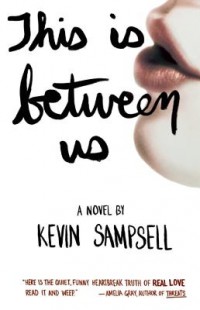 This Is Between Us
This Is Between Us
by Kevin Sampsell
Tin House Books, 2013
240 pages / $15.95 buy from Powell’s or Amazon
1. This book reminded me of this remix which was incredibly moving and pained me this spring and still pains me now http://www.youtube.com/watch?v=0KbdOBE1ORw
2. The thing about Kevin Sampsell is that he feels like the kind of guy who has been through everything. He’s just one of those people. He doesn’t have that used up feeling or look at all but he does have that vibe of being the kind of guy who has lived through basically everything there is as a human to experience but not in a hardened way.
3. I’m not explaining this right but he’s just one of those people who seems complicated and well adjusted and like if you talk to him he just has been there, whatever it is but he doesn’t come outright and say that instead he just comes from this I know what you mean mode which isn’t even patronizing the point here is that all of that also comes through in his writing and this book This Is Between Us from Tin House coming out is five years of a life.
4. Anything you have ever experienced in your life is in this book.
5. This book is comforting.
6. Sometimes this book is upsetting.
7. This book is comforting.
8. Some people said this book was disturbing and I was like have you ever lived your life at all or ever really loved someone or had a partner and if you haven’t maybe your life is easier and even if your life has been really nice you’ll still be like “yup” while reading parts of this book because it’s just so real in how it’s rendered because it’s just written so elegantly and simply stated and maybe that’s the thing with Kevin Sampsell’s writing.
9. We’re working with the rhetorical you in this entire book.
10. It’s written like a confessional ode-ish poem. READ MORE >
November 7th, 2013 / 1:06 pm
25 Points: Götterdämmerung Family BBQ
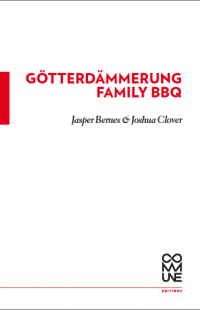 Götterdämmerung Family BBQ
Götterdämmerung Family BBQ
by Jasper Bernes and Joshua Clover
Commune Editions, 2013
read, print
1. I met Jasper Bernes at a café in Oakland. He was binding Götterdämmerung Family BBQ with a long arm stapler. Commune Editions is a new publishing venture organized by Jasper Bernes, Joshua Clover, and Juliana Spahr.
2. Jasper invited me to the Poetry and/or Revolution conference-taking place at UC Berkeley, Davis, and Santa Cruz. I went to a discussion on manifestos where Joshua Clover delivered his Don’t Put the Rabbit in the Hat. Later, at “The Public School” Joshua and Jasper read from Götterdämmerung Family BBQ.
3. If it’s not clear you can read this online here along with works by Juliana Spahr, Diane Di Prima, and Louise Michel.
4. Poems. These are poems. Don’t forget. They look like poems. They taste like poems. They’re also full of frenetic pop culture references and blatant political antagonisms. They’re fun, but they’re trying to fuck shit up all the same.
5. The line that got the biggest cheer / laugh / reaction from the reading was “I wandered lonely as a drone / That floats o’er jails and landfill / And monitors what we say on the phone. // It knows an amazing amount / About One Direction / And sexting with frenemies of / the public good, who burn in the sun // of total transparency, / brains open to the screen / Memories of one Friedrich von / Ludwig von Mises on scene…”
6. There’s a kind of opulence to lyric like that – a lyrical richness, a sickly sweetness from the rhyme, an excessive beauty. Some other writers, like Julian T. Brolaski, and Joyelle McSweeney, also capture a kind of perverted poeticism, a lavish absence, bastard cousin of luxury rap. “I’m early to the party but my ‘rarri is the latest.”
7. While “I wandered lonely as a drone” pleases, much of the rest of the chapbook is more of a call to arms and a more vigorous critique of political ambivalence. “Your vocabulary did this to me and millions like me, the vulnerability of words wanna be starting something else: rockets, rain, renegacy. Turn it upside down and set it on fire / is too a solution if you believe in emotional truth”
8. Responsibility, commiseration, complicity. This work sits firmly on the let’s do something with our poetry side of the aisle, rather than the “everything is meaningless” or the “poetry can’t do real shit” side of the weird looking aisle.
9. Jasper told me that Commune Editions would focus on work with an anarchist lean. Publishing a recounting of the trials of Louise Michel achieves that in more than one way.
10. “We once thought that there was more to life than breathing carbon emissions through the holes in our faces and we were right” READ MORE >
October 31st, 2013 / 12:31 pm
25 Points: Gulag
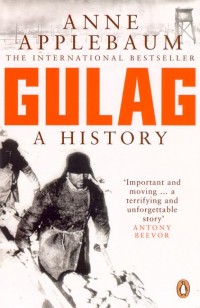 Gulag
Gulag
by Anne Applebaum
Anchor Books, 2004
736 pages / $18.95 buy from Amazon
1. Roughly speaking, the Gulag was the soviet prison camp system that operated from about 1919 through the late 1950’s, though some camps lasted right up until the collapse of the Soviet Union itself
2. Anne Applebuam, the author of this work, has never been a prisoner in a Gulag. In fact Applebaum is pretty much the total opposite of most people who were in the Gulag system, who were by and large poorer Russians and eastern europeans of various national origins. Applebaum is a member of America’s patrician class. She went to Yale and Oxford, worked as a foreign correspondent for The Economist, and is married to the foreign minister of Poland.
3. I can’t help but wonder if one reason Applebaum decided to tackle such a grim, destitute subject is because, like many people who have a fairly secure, lofty station in life, they are morbidly fascinated by the sheer horror of tragedies beyond their geographic and chronological frame of reference. (note: while I am not a member of said lofty station, I am not currently starving to death and am myself often fascinated by horrific national tragedies)
4. I don’t want you to think that Anne Applebaum simply wrote this book out of some universe of vast privilege and is just sort of casually looking down and and trying to explicate history like the Queen of England talking about what’s happening in Syria with the Prince of Wales at afternoon tea or something. The Gulag system as a topic is so enormous, so horrifically cruel and violent, that she obviously had to submerge herself into it to a degree and for a length of time that most people, let alone most writers of history, would probably find appalling.
5. To be honest, I think her outsider status here works to her advantage more than anything. Most of the Russian language works about the Gulag she cites are very emotionally powerful, but they tend to become monotonous and sort of blend all together in a single,very Slavic voice of total despair. You can only read so many descriptions of old women bitterly weeping while receiving their daily bread ration before it becomes this easily dismissible rhetoric of misery.
6. This book is about 700 pages long. About 110 pages of that length is source notes and bibliographical information of one kind or another. Anne Applebaum offers a tidal wave, like an actual wave that engulfs you, of background information and first hand accounts of what life was like in the Gulag system.
7. While reading it I kept wondering if I would ever have it in me to write a 700 page long book of which 1/7 is pure reference information. I mean, I get that people do that sort of thing for a PHD, but that is presumably a big incentive to finish a book. Did she get some kind of advance for this? Or was this just a kooky little pet project she nursed along for years on her own?
8. This is the single most painful work of non-fiction I have ever read.
9. No, really.
10. If the perpetrators of the Holocaust were, as Hannah Arendt famously wrote, committing the banality of evil, then the Gulag system is about the banality of apathy. At no point was the cruelty of the system or of the administrators of the camps or the guards ever mandated. The purpose of the Gulag was never that of the Nazi camps (even if they do bear horrific similarities), in fact, the actual idea of what this whole prison camp system was for fluctuated a lot over time. Sometimes it was about trying to rehabilitate prisoners, sometimes it was about using their slave labor to turn a profit, sometimes it was just about getting rid of undesirable elements and sending them 10 time zones away in the arctic waste. Though that last thing is literally the only thing it did that actually worked. READ MORE >
October 29th, 2013 / 12:15 pm
25 Points: Vintage Attraction
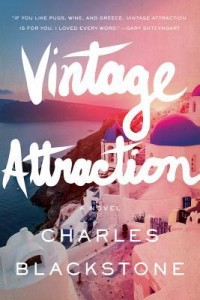 Vintage Attraction
Vintage Attraction
by Charles Blackstone
Pegasus Books, 2013
304 pages / $24.95 buy from Pegasus Books or Amazon
1. Charles Blackstone is the managing editor of Bookslut, which is a nice outfit with a long-standing thing going on and you can read them at: www.bookslut.com
2. I prefer to call him Charlie and he is fine with that.
3. This novel is about a guy who is in love with a famous girl in Chicago who is a wine expert and has her own restaurant thing going on and her own tv show and the guy contacts her as a fan and then they elope and then five weeks later he thinks she is cheating on him and also they aren’t even getting along really and then they are taking a trip to Greece together.
4. There isn’t any gore or devastating kind of art going on in it what it is instead is more of a vibe of like you’re on a second date with someone you really like and it’s a picnic and you just want to seem really nice because you actually think your date is really nice so you use proper grammar. Don’t even lie you know you look really cute when you dress up sometimes. I want to say this book has a tone you’d use in a job interview but that wouldn’t be helping anyone.
5. Also our narrator has an incredibly sad type of way about him which I am basically a complete sucker for but that is fine.
6. This guy in the novel is an adjunct professor.
7. It has this kind of little nervous guy thrown into a big city feel to it because he like asks this girl out and then they’re married and he has to keep up with her life.
8. Have you ever felt like you had to keep up with someone and was it exhausting.
9. I think this entire novel may be a metaphor for the history of wine. Tolstoy.
10. They’re running around Greece trying to either fix or break a marriage they’ve been in for five weeks. READ MORE >
October 22nd, 2013 / 11:09 am
25 Points: Life Cycle
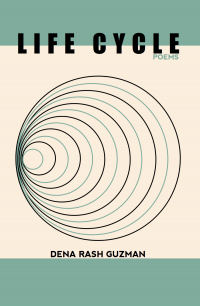 Life Cycle
Life Cycle
by Dena Rash Guzman
Dog On A Chain Press, 2013
69 pages / $10.00 buy from Powell’s
1. Dena Rash Guzman climbs trees and sports cowboy boots and straw hats.
2. Many men drown at sea.
3. All the poems are titled Life Cycle to avoid/create/engender confusion.
4. Handless children populate the poppy pods.
5. DRG has been to China and beyond in search of the muse.
6. Farm weddings do not feature high on her list of favorite events.
7. Bones sleep, are tossed, and itch in these poems.
8. I spent one hot summer in Portland once, some years ago, and did not bump into the poet.
9. I have written several poems lately dealing with loss and aging, and “This is how we forget our ancestors:” shakes the dust off my own family skeletons.
10. DRG reads her poetry live more than most writers I’ve come across, and I’m not sure this is due to her brilliant reading, or Portland, OR, having more readings per square mile than Brooklyn, NY. READ MORE >
October 8th, 2013 / 2:47 pm
25 Points: Radical Love
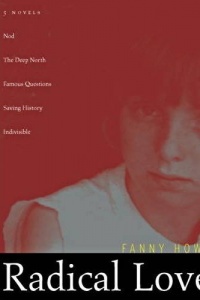 Radical Love
Radical Love
by Fanny Howe
Nightboat Books, 2006
627 pages / $19.95 buy from Nightboat Books or Amazon
1. While reading Radical Love I was living close to the ocean and swimming every day. One afternoon I was feeling sad so I swam out farther than usual, surpassing all of my customary stopping-points, until I was so far out that I suddenly doubted if I’d be able to make it back. I recognized in what I was feeling the preliminary symptoms of panic; racing heart, flushed cheeks, repetitive thoughts about the panic I was feeling which only succeeded in increasing the panic. I floated on my back, trying to breath steadily. The stretch of beach I’d walked on only minutes earlier was now impossible to approach, a landscape which in its brazen totality had become not only remote but imaginary.
2. I realized that the ocean was terrifying because it was the opposite of lonely; it was abundant. By traveling so far from the shore I’d become an indistinguishable element of that abundance. The terror of my slow, lucid ego-death coupled with the necessity of moving my legs to keep myself alive was a stronger feeling than any kind of loneliness I’d ever experienced.
3. I arrived at Fanny Howe through an interview she did with Kim Jensen of Bomb Magazine.
4 . In the interview she describes her poetics as a reaching towards the ungraspable, the fragmentary, the bewildering. Her preoccupation is with the bentness of time. The freakish all-possible of moments, the vastness of living in simultaneity. How can two people be in two places at the same time? Or: How do we express actions occurring simultaneously?
5. There is a rare precision to her words. They scrape softly and insistently at a very particular feeling. In feeling it for the first time I realized it was a feeling I had always felt. A familiar estrangement. Like seeing a stranger in a dream for the second time.
6. The feeling is intimate with the abject. Between subject and object, the barely separate, like a limb cast-off or a corpse. It follows that many of the subjectivities in her novels are displaced and marginal; madwomen, children, monks. Kristeva writes that the abject inherently exists apart from the symbolic order of language, as a trauma irreconciliable with subjecthood. Fanny Howe makes a language for which abjection is immanent (a new subjectivity?)
7. A Sensual Metaphysics. There’s a body-depth to her narratives, a sense of being weighted, but not weighed down.
8. “She went to the caravan on her sister’s black bike through the dark and felt this way the happiness of being a hard sea animal that machines its way gracefully through the ecstatic interiors of the outside world.”
9. “She began to harden with the first baby. A firm heel slid across the palm of her hand, under her navel, now like a moonsnail with a cat’s eye at its apex. Her wastes, and the baby’s, moved in opposite directions from the nutrients. Her breasts tightened to tips of pain. She entered her psyche daily on rising…”
10. How do you write from inside madness? Most accounts of people going insane seem to come from after or outside psychosis, stressing the role of narrative as a stabilizing and ultimately redemptive exercise. In these texts there is more of a return to madness through narrative. No one is saved and everyone is ecstatic. READ MORE >
September 26th, 2013 / 2:37 pm
25 Points: Hunger
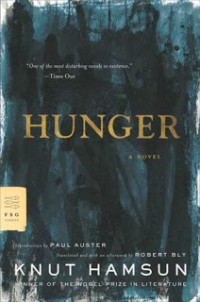 Hunger
Hunger
by Knut Hamsun
Farrar, Straus and Giroux, 2008
272 pages / $16.00 buy from Amazon
1. This is an article about Robert Bly’s (b. 1926) translation of Hunger by Knut Hamsun (b. 1859). It was published by FSG in 1967.
2. The cover graphic is the word HUNGER stylized as an open mouth with 2 rows of sharp teeth. I bought my copy in January 2013 from a used bookseller in Toronto. The clerk said it was her favorite book, esp this edition because she liked the cover. The design is not credited in the edition notice.
3. Knut Hamsun is clean shaven and wearing a monocle in a photograph taken in 1890, the year Hunger was first published in Norway. In later photographs he is moustachioed and wears glasses. In the last known photographs of Hamsun he wears a large white beard and squints.
4. The first several times I read Hunger by Knut Hamsun was in a hardcover edition translated by George Egerton aka Mary Chavelita Dunne in 1899. This review is not about that translation, nor is it about the 1996 translation by Sverre Lyngstad.
I am descended from Norwegians but know nothing of the language. This article is not as much a review of the translation itself as it is a discussion of the fact of its publication in 1967.
5. The main introductory essay to Bly’s translation is by Isaac Bashevis Singer (b. 1902) noted Jewish-American author and pioneer of modern Yiddish literature.
“Writers who are truly original do not set out to fabricate new forms of expression,” says Singer, “or to invent themes merely for the sake of appearing new. They attain their originality through extraordinary sincerity.”
6. “People do not love alike, neither do they starve alike.” (Singer).
7. Hunger is about a young man with artistic leanings living in Kristiania, Norway. From biographical details about Hamsun we can guess that the story is based on Hamsun’s own experiences and takes place in in 1879-80.
Hunger itself does not offer much in the way of context. It is a first person account of a young man living alone in a city. He appears to have no awareness of anything outside his own need, which is mostly for food. He is starving and desperate, but the private code by which he lives forbids him from taking work that he considers to be below his abilities.
8. His mental state throughout is ostensibly a result of his being hungry, rather than a symptom of mental illness or PTSD for example. He cycles rapidly through extreme moods: hilarity, despondency, optimism, despair, loneliness, social anxiety etc.
9. Doubt is the driving force behind the narrator’s racing thoughts. His doubt tirelessly regenerates itself. Doubt is what drives the desperation and sets its parameters. It is what keeps need always at the centre.
At every moment he is like a reckless gambler who has already placed his bet before realizing the stakes are too high, and then in a panic must cut his losses before waiting to see the outcome.
“He was a man before his time,” says Singer, “His skepticism, or perhaps it could be called pyrrhonism — doubting even the doubts — belonged to a later era. To Hamsun man was nothing but a chain of moods that kept constantly changing, often without a trace of consistency.”
10. “Fictional heroes who are estranged from their environment seldom emerge lifelike,” says Singer, “With most writers, such heroes are mere shadows, or, at best, symbols. But Hamsun is able to portray both the environment and the alienation, the soil and the extirpation. His heroes have roots even though they cannot be seen.”
There is almost no historical or social/political context in Hunger. In most novels of the era that would be seen as a fault. In Hunger it is seen as a strength.
As a reader I only interact with the narrator’s environment as needed. That is because the novel is not about Norway or Europe: it is about being hungry. READ MORE >
September 19th, 2013 / 2:53 pm
